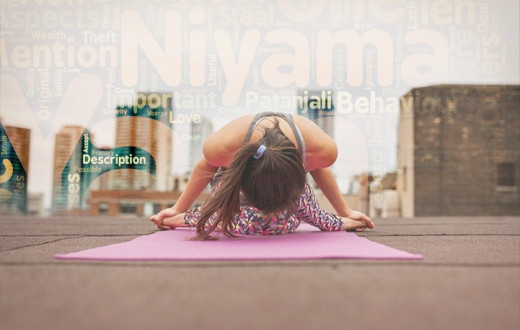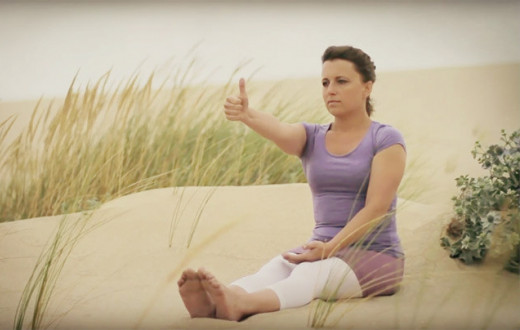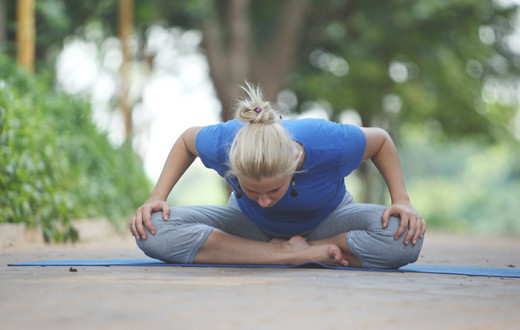
Shoulder stand is a staple inversion posture. Shoulder stand is known as the queen of asanas because of the long list of benefits it can give. Strengthening the spine and core muscles is just the beginning of what you can expect when practicing shoulder stand. See our list of all of the benefits below.
In Sanskrit, shoulder stand is also known as Sarvangasana (Sar-van-GAHS-uh-nuh), sarva, meaning all, anga, meaning limb, and asana, meaning posture.
Seen as an advanced pose by many, shoulder stand can be practiced by beginners with proper guidance. Step-by-step instructions, modifications and precautions are all included below.
Level of difficulty: Intermediate
Things to know about shoulder stand pose
Just like with any yoga asana (pose), it’s important not to strain, and only do what your body can do at the moment. If you have never done a shoulder stand, preparatory poses will be especially helpful with this pose. It may also be helpful for first-timers to have guidance from a yoga instructor.
Benefits of shoulder stand pose

Here are some of the many health benefits of practicing shoulder stand:
- Stimulates the thyroid and parathyroid glands
- Improves hormonal balance
- Strengthens the arms, shoulders, and upper spine
- Increases flexibility in the spine
- Increases blood flow to the upper back and brain, energizing the nervous system
- Improves blood oxygenation
- Increases core strength
- Cures constipation and improves digestion
- Increases circulation in the lymphatic system
- Helps manage insulin production
- Engages the parasympathetic nervous system
- Harmonizes the throat chakra (energy center)
Precautions for shoulder stand pose
Always seek the advice of a medical professional if you have any concerns about doing shoulder stand pose.
If you have any of the following conditions, please avoid shoulder stand.
- High blood pressure
- Glaucoma
- Detached retina
- Spine, shoulder, or neck injury
- Obesity
- Later stages of pregnancy
- During menstruation
- Osteoporosis
Preparatory poses and follow-up poses
Shoulder stand pose is included in a series of fluid yoga poses called Padma Sadhana, designed by the Art of Living. This short sequence is perfect to practice before your daily meditation practice.
We have also included individual yoga poses to stretch before and after shoulder stand.
- Padma Sadhana (Preparatory and follow-up)
- Boat Pose (Preparatory)
- Bridge Pose (Preparatory)
- Plow Pose (Follow-up)
Browse more yoga poses in our extensive yoga pose library to learn more about each yoga pose in detail.
Step-by-step instructions for shoulder stand

Lie on your back on a yoga mat. You may use a folded blanket underneath the shoulder blades. Align the head, spine, and legs. Keep your feet shoulder width apart. Place your hands beside the body, palms pressed down. Visualize yourself moving into and out of the posture with balance and control.
- Inhale, keep your core engaged, and place your hands under the buttocks for support. On your next inhalation, raise your legs straight to a vertical position. If you imagine a clock, your legs are directly up at twelve o’clock, while your body is still flat on the ground.
- Exhale. Take your legs over your head, keeping them vertical, until the buttocks and spine are off the floor.
- Bend your elbows and place your palms vertically behind the rib cage to support the back. Push your chest forward so it presses against your chin.
- Lift your legs up so that the entire length of your body, from the shoulders to the tips of the toes, is in a straight line (six o’clock). You can lift one leg at a time if you're a beginner.
- Fix your gaze on your toes.
- Breathe normally and relax in the pose for four to five long, deep breaths, or as long as is comfortable. Your entire body should rest on the shoulder blades, upper arms, and elbows. Avoid putting too much weight on your neck and head.
- To come out of the posture, exhale and bring your torso down to the floor. Bring your legs back to where they were in step two (twelve o’clock), and then to the floor.
- Relax your entire body weight in corpse pose with palms facing toward the ceiling until your breathing and heart rate return to normal.
Notes:
You may add plow pose between steps five and six. You may also wish to do fish pose after shoulder stand for a counter stretch.
Modifications and variations
- If you’re new to shoulder stand, use a wall to do a supported shoulder stand. Sit sideways against the wall, with your left side touching the wall. Inhale, and on an exhale swing your legs up onto the wall. Your buttocks should touch the wall, and your legs should be straight above your hips. Bend your knees with care, and lift your hips away from the wall. You can stay here, or continue moving your legs completely off the wall for the full posture.
- You can also substitute bridge pose for shoulder stand until you have the strength and confidence to do shoulder stand.
Take a deep breath and enhance your yoga practice with SKY Breath Meditation
Breathing is vital to life and your yoga practice. SKY Breath Meditation enhances both! Here are just a few ways SKY can help you live a happier and healthier life!
- Reduced stress
- Improved immunity
- Increased energy
- Greater mental focus
- And more…






























